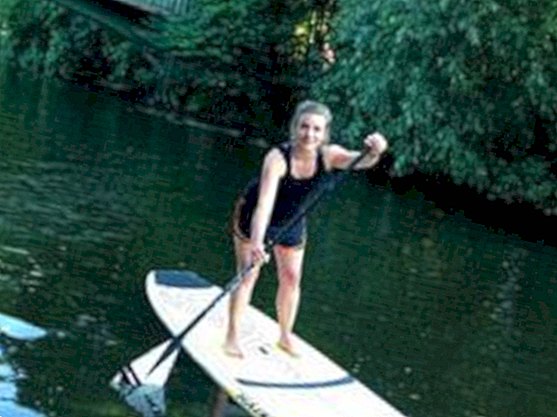Stand Up Paddling: Walking on the water

 © Nicole Wehr
© Nicole WehrSomething out of the breath of the delay-the-Anradeln across Hamburg, I open a white-painted gate. Ingo Rotermund greets me three steps further: barefoot and in boardshorts he stands in front of a wooden hut in the fine sand which he poured down next to the boathouse Barmeier in the Eppendorfer Hayns Park last year. A firm handshake, a "relax first!" and a Klamottentausch in the changing cabin later, I trample with bare feet, in shorts and shirt (both quick-drying, you never know) to my coach.
I would like to try Stand Up Paddling (short: SUP) - that means: Standing on a surfboard over the water. A few months ago, I had smiled two wetsuit and puncture paddle through one of the Alster canals staksende people. Wannabe gondoliers. But then, lately, at lunchtime, the rapturous rapture of a colleague made me enjoy! Switch off! Healthy! - curious.
Paddling with stretched arms
Not a week later I stand with SUPco and let Ingo show me how walking on the water is. The most important thing, the paddle technique, he explains to me in the dry. It has little to do with traditional paddling: Similar to the Canadians, the arms stay long, you pierce the paddle perpendicular to the water surface, dipping the whole leaf and pulls it by the core muscles to the body. About 25 inches longer than you should be the paddle. Means: If the upper hand grips the knob, the arm should be straight, but not fully extended. The lower hand grips the shaft - far enough down that a right angle is created in both elbow joints when the paddle is held over the head.
After the rectangle test it goes on the jetty. And on your knees. In the quadruped stand, I bring myself in position - parallel to the board, which is in the water. The so-called sups are bigger, lighter and wider than normal surfboards. You can not hurt yourself here as fast as surfing or windsurfing. The sooner the first successes come about, says Ingo. Let's go then: right knee on the board, left behind, paddle across it, repel. A bit awkward I steer the board and me away from the jetty and to the bridge, behind which the Alsterarm widens.
Do not look down
"So, and get up now," says Ingo, who has already paddled. Just do not embarrass, I think and swallow my discomfort. Paddle on the board, hands in front of the knees, look straight ahead (not on the water), place feet one after the other, grab paddles and straighten up. Do not think much, just do it - it works amazingly well. My feet are centered on the board, they frame the handle, with which it pulls ashore. I go through the checklist internally: legs hip-width, knees slightly bent, upper body forward, back straight, paddle with stretched arms into the water, pull back to the feet, stand upright, repeat. Is working!
But I do not need to think too much about that, because: "Actually Stand Up Paddling is suitable for everyone, no matter how old or fit," says Ingo. You should only be able to swim. A good body tension and a sense of balance helps - people with gymnastic, yoga or Pilates experience are clearly in the advantage. With proper technique you train with it the entire core muscles and stabilized especially the lumbar area. Also pelvis, legs and butt benefit from the stand-up paddling. The good thing about SUP: You do not need wind or waves for the mix of coordination and full-body training. Just fancy fresh air and water.
Curious? Hamburgers can rent board or paddle at SUPco or book courses. But in many other cities, there are now SUP providers.
SUP - trend with tradition
What is still regarded as a trend sport in this country has been practiced by fishermen off the African coast and in Polynesia centuries ago: they stood upright in flat canoes made of tree trunks to better understand their prey. In Hawaii, it was originally reserved for the king to paddle while standing. In the 1950s, surf instructors discovered Stand Up Paddling for themselves, as it enabled them to better watch their students and get to the reefs faster. After surf star Laird Hamilton stood with a paddle standing under a monster wave, also recreational athletes in the SUP tried. Together with California, Hawaii is still the stronghold of stand-up paddling. Since 2009, there is a separate competition series for the sport, the stand-up world tour of the Waterman League. In Germany, too, the world's best paddlers now compete against each other - for example from 16 to 18 August in the Hamburg Hafencity at the SUP World Cup.










